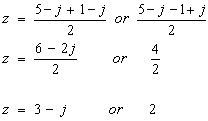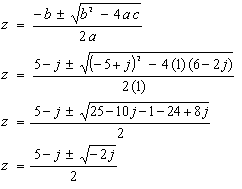sqrt(-2j) = 1 - j OR -1 + j
Using this "fact", we proceed to the solution:


Can you show me how to solve the equation None of us could do it in class - even the teacher got stuck! (I am doing Further Maths A-level) |
Preliminary comment: This topic of complex numbers occurs in the "further" pure maths
syllabus at A-level. Complex numbers are also dealt with in some higher engineering courses.
Some textbooks use i for the imaginary value sqrt(-1), some use j.
In this question, j2 = -1
Let's look closely at your equation.
z2 + (-5 + j)z + 6 - 2j = 0This is basically a quadratic, in the usual form
az2 + bz + c = 0where a,b,c are coefficients. The only special thing here is that they are complex:
a = 1Substituting these values into the well-known equation for the roots of a quadratic, we get
b = -5 + j
c = 6 - 2j

At this stage we pause - what is the square root of -2j? Finding the square root of a complex number is fairly tricky (but it is an important technique in Further Pure Maths A-level papers). We will explain at the end of this page how to do it.
For now, just accept that:
sqrt(-2j) = 1 - j OR -1 + j
Using this "fact", we proceed to the solution:

How do we check these solutions are correct? The long way is to substitute them for z in the
original equation, and verify that the left hand side does simplify to 0. A neater way is to
recall the standard result for roots of quadratics:
Sum of roots = -b/aI suggest you carry out each of these checks for practice.
Product of roots = c/a
EXAMPLE
Find the square root of 7 + 24j
METHOD
We assume that the answer will be another complex number. Call it u + vj, where u and v
are real numbers. Thus:
u + vj = sqrt(7 + 24j)Comparing real and imaginary parts gives us two simultaneous equations in u and v:
(u + vj)2 = 7 + 24j
u2 + 2uvj + v2j2 = 7 + 24j
u2 + 2uvj - v2 = 7 + 24j
u2 - v2 = 7 ....(1)From (2) we have
2uv = 24 ....(2)
v = 12/uSubstituting for u in (1) gives:
u2 - 144/u2 = 7The second option is not possible, because u must be real (see statement at the beginning).
u4 - 144 = 7u2
u4 - 7u2 - 144 = 0
(u2 - 16)(u2 + 9) = 0
u2 = 16 OR u2 = -9
u2 = 16Substituting these values for u back in (2) gives
u = 4 OR -4
when u = 4 , v = 3Therefore the square roots of 7 + 24j are
when u = -4 , v = -3
4 + 3j OR -4 - 3jNOTE: Just as with real numbers, there are two square roots of a complex number, of opposite signs.
EXERCISE:
Use the method above to show that sqrt(-2j) = 1 - j OR -1 + j